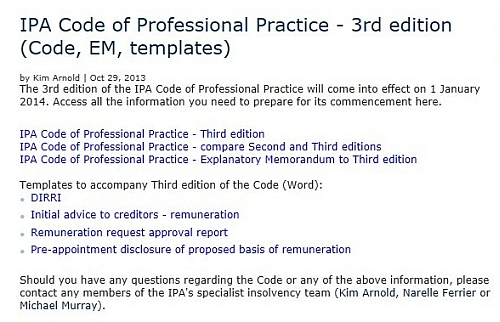The Insolvency Practitioners Association of Australia (IPA) has suggested that solvent companies pay a fee to fund the liquidation of small assetless companies. The proposal is that this new pool of funds be used to pay a set fee to liquidators who are willing to do the work.
The IPA’s proposal is made in its July 2011 submission to the Treasury, in response to an Options Paper on regulation of insolvency practitioners.
This fund would be in addition to the existing Assetless Administrations Fund (AAF). The problem with the AAF is that it is not open to liquidators of assetless companies unless and until they have conducted preliminary investigations and made preliminary reports to the Australian Securities and Investments commission (ASIC), and then only for the purpose of paying for additional investigations and reports by liquidators where it appears that directors ought to be banned or prosecuted.
The IPA is the professional body covering over 85% of registered insolvency practitioners in Australia. In its submission, forwarded this week to members, it says:
“Currently there is no process for an assetless insolvent corporation to be wound up in the absence of a director or creditor able and prepared to indemnify the practitioner’s remuneration. In the case of a court liquidation, practitioners are required to conduct the administration with no prospect of remuneration.
We recommend the establishment of a fund to have practitioners wind up small assetless corporations, on the basis of a set fee available either to all providers, or to a panel of willing providers **, and with the ability for the practitioner to apply to the current assetless administration fund if their work identifies the likelihood of offences. (** As an example, under the regime operating in Hong Kong, practitioners bid for work of this kind quoting a fixed fee for the administrations they would undertake.)
This scheme could be funded via a levy imposed at the time of initial company registration, or by a small annual fee charged on every corporation. The large number of corporations at any time means that the annual fee could be very low and still provide adequate funds for the operation of the scheme.
There are very low barriers to the formation of a corporation inAustralia, and every corporation in the economy benefits from the health and reliability of the insolvency regime. While the frequency of insolvent administration is very low, any corporation has the potential to enter the insolvency regime at some future point. It is therefore reasonable that the costs of administering assetless insolvent corporations be born equally by corporations across the economy.
An alternative approach would be for ASIC to administratively deregister such companies without a formal insolvency process. (But) In our opinion, this option would encourage poor corporate behaviour. By ensuring that a company is left with no assets in the event of insolvency, a director might seek to avoid any investigation into the failure of the company and any possible breach of duties.
The recommended approach ensures that a minimum level of investigation is done which can lead to further applications for funding in the event that offences or recoverable transactions are identified.
Such initial funding to wind up these companies would also:
• Ensure protection of employees’ rights by allowing employees to access the GEERS scheme (or any such replacement arrangement); (GEERS is the General Employee Entitlements and Redundancy Scheme, administered by the Department of Education, Employment and Workplace Relations)
• Provide a deterrent to poor corporate behaviour by directors, though this needs to be supported by a proactive corporate regulator; and
• Assist ASIC to identify directors who should be banned from continuing in such a role. “
_____________________________________________________________________
The IPA submission – which is 36 pages long and seems to respond to all the issues and questions raised in the Options Paper – will be published, along with all other public submissions, in a few weeks.
